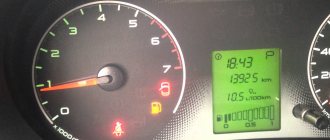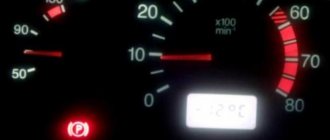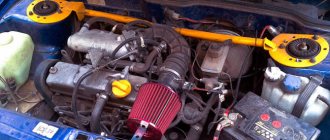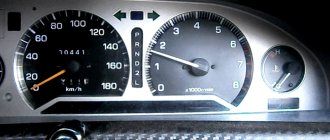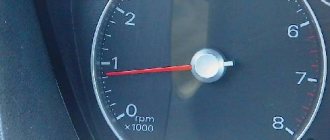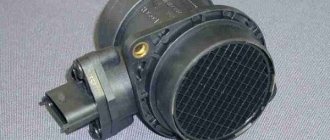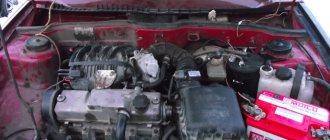Every vehicle owner, sooner or later, may experience problems associated with engine interruptions, regardless of the manufacturer and model of the car. Lada Priora is no exception. Therefore, as the owner of this car, you should be a little prepared for such situations so that they do not take you by surprise.
Drivers of the Lada Priora may encounter a situation where the engine speed fluctuates, often at idle. This is a problem for both vehicles with a carburetor and an injector in the configuration. Even the most popular foreign cars are not immune from such problems.
Plus or minus: why the Priora's revs fluctuate in different conditions
Reliable control of a carburetor engine has long been replaced by flexible electronics. The latter consists of a control unit and sensors operating according to a specific program. This trend has led to increased power and decreased fuel consumption. However, with the advent of electronics, the control system has become more vulnerable to malfunctions.
Your own diagnostician: why the engine speed fluctuates on a Priora - a theoretical basis
The VAZ 2170, like the Ten, is equipped with a distributed fuel injection system. Engine performance here is determined by the amount of air captured from the atmosphere, and in turn is determined by the throttle angle (DZ). Based on the sensor readings, the computer calculates the amount of fuel that needs to be injected into the intake manifold to achieve the optimal fuel-air mixture.
There is only one answer to the question why the speed on Prioress fluctuates: the computer incorrectly perceives or does not know at all the amount of air in the manifold. And this happens for a reason:
- failure of the mass air flow (MAF) sensor;
- failure of the throttle position sensor (TPS);
- air leaks;
- The idle air regulator (IAC) is faulty.
In this case, the engine will increase the speed of the power plant, while the volume of injected fuel will remain the same. This means that the mixture will be leaner and the engine will begin to stall smoothly.
As the crankshaft speed decreases, the amount of air decreases. After reaching a critical point, when the injection volume of high-octane liquid is sufficient to obtain a fuel mixture of normal quality, engine operation stabilizes again. This process is called "swimming revolutions". It is closed, it will be repeated until the reasons are clarified and measures are taken to eliminate them.
More details: why after cleaning the throttle valve the idle speed begins to float and a little about other malfunctions
The throttle body (TV) is often cleaned due to clogged channels and "idle" space between the shock absorber and the throttle body. In this case, the following symptoms are observed:
- after releasing gas, the engine runs unstable at idle or stops completely;
- The engine starts only when you lightly press the accelerator pedal.
In advanced cases, even a cold start is difficult. It is noteworthy that this is considered a malfunction that can be eliminated by decoding the car’s engine.
For reference. The cause of clogged remote control channels is dust particles associated with oil. And they enter the intake manifold from the crankcase.
The operation of assembling the remote control and reintegrating it into the air intake system does not always go unnoticed. Quite often, after cleaning the throttle valve, the idle speed floats. There is only one reason: the supply hoses are not securely fastened. The treatment recipe is simple: tighten the clamps.
Instability of XX before turning on the fan and after turning it off
Most often, this defect is associated with a rupture of the adsorber valve. Before turning on the fan, begin to ventilate the tank. If it remains locked in the open position, the idle frequency will no longer be stable.
The following diagram will help verify that the canister valve is faulty:
- Start the engine.
- Pinch the tube going to the canister valve with pliers.
- Check the behavior of the XX control unit: if the internal combustion engine stabilizes, the valve is blocked and must be replaced.
Instability of engine speed when braking with the brake pedal
As you know, the braking system of the Lada Priora is equipped with a brake booster (BUT). It consists of a housing and a diaphragm that divides the VUT housing into two cavities: vacuum and atmospheric. In the initial position, these two chambers are connected. When the brake is pressed, the atmospheric chamber communicates with the atmosphere and presses on the membrane, facilitating the movement of the pedal.
Thus, if the membrane is damaged, the atmospheric region is connected to a vacuum. The latter is connected to the intake manifold (and a vacuum is constantly created in it), so air is sucked in at the entrance to the combustion chamber. The controls are simple:
- Remove the booster inlet hose from the intake manifold.
- Plug the hole for the VUT at the inlet.
- Start the engine.
- Press the brake pedal: if the idle pedal is stable, replace the “vacuum cleaner”.
For your information. In particularly advanced cases, the engine simply stalls when braking. In winter, it is necessary to eliminate the malfunction as soon as possible, otherwise even the best car battery can run out after just a few engine starts.
Why, after starting the engine, the crankshaft speed increases to 1,200-1,500 rpm, and then drops to 800-900 rpm and returns to its previous values?
Such symptoms in 70% of cases indicate a malfunction of the mass air flow sensor. If the engine is running at the same time, the coils must be checked.
For your information. The mass air flow sensor is designed in combination with temperature and atmospheric pressure sensors. Its direct function is to estimate the amount of air sucked into the engine intake.
Important: checking sensors
The answer to the question why idling on Priora floats can often be as follows: one of the three sensors (IAC, TPS, DMRV) is faulty. The controls are quite simple:
- We're starting up the power plant.
- Disconnect the IAC power unit and analyze: the IAC frequency remains the same or the motor stalls - the sensor is ready for replacement. If the speed is increased, the sensor is working.
- Restore power to the regulator.
- Throw the chip away from the TPS and observe: the speed has increased - the DFID is working; If the engine stalls, the mass air flow sensor needs to be replaced.
- Connect the power supply to the TPS.
- Disconnect the block from the mass air flow sensor and analyze: the crankshaft speed has increased - the TPS is working, the engine stops - the throttle position sensor is faulty.
- We connect the microcircuit to the mass air flow sensor.
For your information. Often the problem is caused by a poor connection of the terminals of both the negative and positive wires.
Route map for eliminating unstable XX on a VAZ 2170
Unstable "minimums" are caused by the computer misperceiving or not knowing at all the amount of air being drawn into the intake manifold. A typical treatment recipe looks like this:
- Check the sensors (IAC, DFID, TPS) and replace the faulty ones.
- Make sure the canister valve is in good condition.
- If, after cleaning the throttle valve on the VAZ 21126 engine, the speed fluctuates, you need to make sure that there is no air leakage through the fittings to the injectors.
- Check the integrity of the brake booster diaphragm.
Important: checking sensors
The answer to the question why the idle speed on a Priora fluctuates can often be this: one of the three sensors (IAC, TPS, MAF) is faulty. It's quite easy to check:
- Start the power plant.
- Disconnect the IAC power supply and analyze: the IAC frequency remains the same or the motor stalls - the sensor needs to be replaced. If the frequency has increased, the sensor is working.
- Restore power to the regulator.
- Remove the chip from the mass air flow sensor and observe: the speed has increased - the mass air flow sensor is working; the engine has stalled - the mass air flow sensor should be replaced.
- Connect power to the TPS.
- Disconnect the block from the mass air flow sensor and analyze: the crankshaft rotation speed has increased - the mass air flow sensor is working, the engine stalls - the throttle position sensor is faulty.
- Attach the chip to the mass air flow sensor.
For your information. Often the problem is caused by a poor connection of the terminals of both the “negative” and “positive” wires.
Why does the speed fluctuate on the Lada Priora and what to do?
Fluctuations in engine speed can occur both at idle and in neutral when the throttle is released, when the engine is cold and when the engine is warm. There are several sources of such “swimming”. You can't do without a full car diagnostic (using a scanner). Let's divide the possible reasons for changes in engine speed into different categories.
Fuel system problems
Perhaps the “heart” of the car is concerned about the improper functioning of the “circulatory” (fuel.
Its elements may become clogged (injectors, throttle valve, fuel filter, cleaning mesh, etc.) and must be cleaned and washed. The reason may have been the use of low-quality fuel.
Check the pressure in the fuel system, the operation of the oxygen sensor - “lambda”, the carbon dioxide content in the fuel mixture, the operation of the catalyst.
Some previous owners drill a 3.5 mm hole in the bottom of the throttle valve to normalize engine performance. It would be a good idea to adjust the angle of the shock absorber itself.
Route map for eliminating unstable XX on a VAZ 2170
Unstable idle is caused by the fact that the computer incorrectly perceives or does not know at all the amount of air sucked into the intake manifold. A typical treatment recipe looks like this:
- Check the sensors (IAC, DFID, TPS) and replace the faulty ones.
- Make sure that the adsorber valve is in good condition.
- If, after cleaning the throttle valve on the VAZ 21126 engine, the speed fluctuates, you need to make sure that there is no air leakage through the connections to the pipes.
- Check whether the diaphragm in the vacuum brake booster is intact.
What to do if the idle speed of the Lada Priora fluctuates
Sooner or later, every car owner may encounter problems associated with engine interruptions, regardless of the manufacturer and model of the car. Lada Priora is no exception. Therefore, as the owner of this car, you should be a little prepared for such situations so that they do not surprise you.
Drivers of Lada Priora may encounter a situation where the engine speed fluctuates, often at idle. This is a problem for both cars with a carburetor and fuel injection. Even the most popular foreign cars are not immune to such problems.
Oil
Many car owners try to change their oil before winter. But not everyone knows that the oil with the lowest viscosity is best suited for winter. Thick oil will simply harden in winter. In addition, when the engine is cold, it is very difficult for it to drive thick oil through the channels. If the picture is complemented by an old battery, then this aggravates the situation even more. Therefore, you need to try to purchase oil of exactly the viscosity at which the engine can start normally even in cold weather. Typically, a product with a viscosity of 5W30 is purchased. But in any case, you need to look at the manufacturer's recommendations. You should not deviate significantly from the tolerances.
Revs fluctuate on Priora
The speed on the Prioreshka fluctuates, such reproaches can be heard quite often against the power unit of this brand of VAZ cars. And, although, according to many experts, the Priora’s engine is generally quite reliable, the car itself, in the language of professionals, is very “raw” and generally requires various technical improvements and improvements. After all, why should our domestic auto industry (at least the light one) consistently “lag behind” foreign manufacturers?
Leafing through automobile information portals, you constantly come across various complaints from motorists, they say, I bought a Priora car, but the speed fluctuates, the car is new, I don’t know what to do, please advise. I contacted the service center and they told me that there was nothing wrong with it, that many cars have this defect, so be patient, but if you didn’t have enough patience, then you had to buy a foreign car, not only from a reputable company, but also, of course, different price segment.
According to experienced motorists, instability of the engine speed (rpm) of a Priora car can be caused by various reasons, so, as they say, who is “lucky”. Such reasons include poor performance of the idle speed sensor or magnetic valve. In this case, the engine will not operate stably in the IAC; starting it will become very difficult, especially when cold, and it may suddenly begin to stall. In general, not to mention the “joy” of increasing fuel consumption. By the way, it is worth paying attention to the quality of the fuel used; sometimes fluctuations in Priora engine speed can be caused precisely for this reason.
In some Priora cars, the engine of which worked perfectly, the Priora's speed begins to fluctuate as soon as the power unit receives additional load in the form of headlights, turning on the interior heating or air conditioning. In this case, you should pay attention to the generator. Well, an extremely radical measure is to “reflash” the system, but this should only be done on a working machine, after carrying out a full diagnostic of it, and in the appropriate specialized service, otherwise, instead of eliminating the malfunction, it is easy to acquire additional ones.
Good afternoon. Tell me, who knows: At idle, engine speed ranges from 0.7 to 1.5 thousand revolutions. All this happens with the engine heated to >70 degrees.
Priora 2007, 16 valves, mileage 65,000 km, semi-synthetic oil Gold engine - mileage 2,500 km. Spark plugs are burning - mileage > 10,000 km. Make sure the engine does not start. The car has direct flow + firmware.
Where to look, how to think?
Posts 8
1 Topic from Alekseevich_1 2016-10-21 16:15:39 (2016-10-21 16:19:24 edited by Alekseevich_1)
- Alekseevich_1
- New member
- Inactive
- Registration: 2016-10-21
- Messages: 1 Thanks : 0
Topic: When it's hot, it stalls when you let off the gas, the speed fluctuates
Hi all! It’s already been 3 weeks since I replaced the timing belt and rollers and I’m struggling with the problem of floating speed and the car stalling when I let off the gas. The main problem is that the car stalls when it is HOT when releasing the gas, especially at low speeds. Sometimes it rattles and picks up speed again, sometimes it stalls. It’s impossible to drive, I no longer know what’s wrong and what could happen. I changed: -IAC sensor -DPS -Cleaned the throttle assembly -DPKV -BB wires -Inspected the spark plugs and cleaned them -Changed the pipe from the adsorber to the block (you could hear a hiss from it, replaced it completely) No results: ((( I would like to change the MAF in last stage The revs float slightly when the car is in neutral. I unscrewed the plug on the receiver, the engine was even more unstable. The engine runs strangely and also stalls. There seems to be no change in the dynamics of the car, the consumption seems to have increased, but I judge this purely from observations. .k. There is no BC. The car starts to stall only when the temperature approaches 90 degrees, before that the car is normal and there are no problems. Starting up when cold seems to be normal too, at first the revolutions slowly rise, then level off. I don’t know if there is any point in computer diagnostics, there are no errors, the check is not lit. I'm afraid that it will be a waste of money. Who can tell me what? I give up, I'll probably ride a minibus soon:( Well, I'm adding a video of this process:
The reliable carburetor engine control circuit has long been supplanted by flexible electronics. The latter consists of a control unit and sensors operating according to a specific program. This trend has made it possible to achieve an increase in power and a decrease in fuel consumption. However, with the advent of electronics, the control system has become more vulnerable to malfunctions.
Tags: Priora, revs fluctuate
Comments 19
Priora 2014, 106 thousand km, 16kl engine. 127, 106cv, air conditioning, abs. There is a gas (distribution) nozzle of the latest generation. The fact is that at idle speed on a hot engine the number of revolutions fluctuates up to 1000 (it is warmed up), but on gasoline this is not so pronounced, it is almost imperceptible and a rare phenomenon, although sometimes you feel it, it happens that you are dragging the speed, you release the pedal, it disappears, and as for the gas, everything is the other way around. Before this, the control light was on, diagnostics showed a malfunction of the throttle mechanism, I thought it was a problem, bought a new one, changed it, retrained it. As soon as we got home, the momentum returned to swimming. What could be the reason, has anyone encountered it? Don’t write about DHH, it’s not in Priores.
Sooner or later, every car owner may encounter problems associated with engine interruptions, regardless of the manufacturer and model of the car. Lada Priora is no exception. Therefore, as the owner of this car, you should be a little prepared for such situations so that they do not surprise you.
Drivers of Lada Priora may encounter a situation where the engine speed fluctuates, often at idle. This is a problem for both cars with a carburetor and fuel injection. Even the most popular foreign cars are not immune to such problems.
Tips and tricks
Let's look at how you can eliminate some of the malfunctions that lead to floating and speed jumps, and do it yourself.
- As mentioned above, the leakage of excess air can cause surges. To exclude or confirm the possibility of supplying such air, you need to check the tightness of the air supply system to the intake. You can remove the air hose and feed it air from a compressor or pump by placing the hose in a container of water. This method helps to identify cracks.
- As for the idle air control, you need to measure the resistance with a multimeter. If the resistance is between 40 and 80 ohms, this means that the device is not working.
- Also, as part of diagnostic procedures, in some cases it is necessary to clean the crankcase ventilation valve. The valve must be removed and washed with carburetor cleaning fluid or kerosene. This approach will remove deposits from the valve.
- As for the ECM sensors, in this case it is not advisable to try to repair such elements. For example, if the mass air flow sensor is faulty, it is better to immediately replace it with a new one.
- It is better to trust specialists to flush the throttle valve without proper experience, especially if such flushing is necessary with the removal of the valve. If we talk about the method of flushing the throttle without removing it, you can do the procedure yourself. The hoses are disconnected from the valve, then a cleaning aerosol is injected into the throttle.
The main thing is to disconnect the electrical contacts from the throttle valve. Let us add that on many cars where the damper was heavily dirty, you then need to additionally set the correct opening gap of the damper or “teach” the throttle using the appropriate equipment.
- On a car with a carburetor, you need to adjust the idle speed by setting it with the quality and quantity screws on the carburetor. The idle jet may also need to be cleaned. To do this, it is often enough to inject a carburetor cleaning aerosol and then blow it with compressed air.
According to drivers, this helps protect the pump from corrosion and is a preventative measure. At the same time, we note that this method is suitable for construction equipment and it is highly not recommended to practice such solutions on modern diesel internal combustion engines.
Lada Priora idle speed fluctuates: reasons, repairs
In the case of the Priora, we have a 16-valve engine with an injector, that is, with an electronic power supply. You can often encounter a situation where the engine speed begins to “sway”, and sometimes the car itself goes into gases, even if there is no effect on the accelerator pedal. This often happens when the engine is hot.
But it also happens at low temperatures when, when starting the car in the morning, the engine operates inadequately. In some cases, interruptions may disappear on their own due to the heating of the car.
First, it is recommended to diagnose the tool to identify the root cause of the malfunction. It is worth considering the following points:
- Is the engine filter clogged?
- Check the condition of the spark plugs.
- Condition of high voltage wiring.
- Make sure the idle air control valve and its electrical system are in good condition.
- Functionality of the oxygen supply sensor.
- Eliminates damage to the temperature sensor.
- Is the on-board computer normal?
Conclusion
If your car has floating idle speed, you must:
- Remember if you have recently refueled at low-quality gas stations.
- Check the system for air leaks.
- Check all sensors that are involved in the formation of the fuel mixture.
- Check the fuel pressure in the system.
All these tips will help you independently find the cause of a breakdown in your car and fix it without much expense.
Source
What to do if the idle speed of the Lada Priora fluctuates
If problem areas have been identified, it is worth making sure that these elements are completely malfunctioning by installing temporary replacement parts. To save money, you can borrow them from your neighbor's garage or use them. And only if the assumptions are confirmed, buy new components. Alternatively, you can contact the nearest gas station, but there is also no guarantee that a “decent” mechanic will not add a couple of extra items to the list of truly necessary parts. It is better to place your main hopes for this only on yourself, while basic knowledge of the principles of operation of internal combustion engines and available relevant literature will be sufficient.
Basic steps such as troubleshooting:
- Check the speed control screw carefully and tighten it if necessary. In this case, the possibility of loss of oxygen will be excluded;
- by pinching the fuel lines one by one, it is easy to determine the presence of cracks or holes in one of them;
- carefully inspect the operation of the throttle valve. In case of premature opening and closing, the problem can be solved by adjusting it correctly;
- Make sure the crankcase ventilation valve is working properly. Its instability is sometimes also the cause of engine malfunction;
- If we exclude all of the above options, then the main reason for the speed fluctuation may be a malfunction of the “brain” of the car, that is, the on-board computer. Only in this case should you contact electronics specialists who will eliminate malfunctions in its operation and restore all processes.
In any case, it is advisable to check the spark plugs, as well as the wiring and distributor.
These manipulations in general will undoubtedly help get rid of the problem.
Reasons for an injector
Now let’s look at the reasons why injection engines have constantly high idle speeds. Unlike carburetor counterparts, where all the problems are with mechanical elements, the injector is stuffed with electronics, so this problem is a failure in the electronics.
The reasons may be:
- Malfunction or breakdown of the sensor that monitors the temperature of the coolant in the engine. If this sensor malfunctions, the speed is not reset, since the electronics believes that the engine has not yet warmed up and drives it in warm-up mode, which is why the increased speed remains. The problem can quickly overheat the engine and cause jamming of parts and severe damage, after which only expensive and time-consuming repairs. A diagnostic scanner can help identify this type of problem.
- A breakdown of the air sensor causes increased speed, as the correct air supply to the engine is disrupted. A diagnostic scanner can also help identify this malfunction. As well as problems with other sensors.
- After this, check the sensor using a multimeter to exclude a broken wiring as the cause.
- A malfunction of the sensor responsible for idle speed, if any, also causes malfunctions at idle speed. If after replacing the idle speed sensor the high speeds do not disappear, then it was not the cause.
- The throttle opening sensor also plays a key role when the speed increases. If it is not working correctly, the computer believes that the damper is fully open and increases the speed, supplying more fuel to the cylinders.
- The sensor may have nothing to do with it, the damper itself is jammed due to dirt, or the spring on the damper, which is supposed to close it, has stretched, in addition, this spring sometimes jumps off or breaks, so the engine keeps high speeds. In this case, it needs to be corrected, if possible, or replaced.
- The damper control cable is stuck. This malfunction was common in older car models. Then it’s worth lubricating or replacing this cable.
- The sealing gaskets on the injectors are damaged. This is a difficult malfunction to check, and quite rare, so it should be checked as a last resort, when other faults have been excluded. Broken gaskets allow air to enter the combustion chambers, which also increases speed.
Useful video about this problem
The injector also has many reasons for such a malfunction, and if it occurs, it is also worth taking care of solving it as soon as possible, before the problems become more serious.
This happened to a friend of mine due to a break in the wiring on the sensor connector, which he discovered after changing all possible sensors, and was about to reflash the computer’s brains. Therefore, in addition to the sensors, do not forget to check the fuses and the condition of the wiring. If there is no visual damage, you can check with a multimeter.
We recommend: Lada Vesta head unit - price, replacement, connection and pinout
This is what could be the reason for high engine speeds, the main thing is to quickly calculate and eliminate it, I have everything for today, subscribe your friends to updates, and subscribe yourself, there will be a lot of useful things, don’t forget to send a link to the site for those who don’t know about it yet, see you.
Mechanical problems
First, you should check the throttle cable. Quite often it jams, and the pedal “sticks” when the driver has already removed his foot and the speed has not decreased. This may be due to the following problems:
- Corrosion of the cable
. At the same time, it simply gets stuck in the shirt; - Lubrication
. Sometimes drivers, in an effort to improve the operation of the unit, lubricate the cable; in winter, the lubricant freezes, which causes jamming;
Unsuccessful repair. In some cases, after repairs, car owners incorrectly position the cable, resulting in problems.
Therefore, be sure to check the condition of the cable. See how it moves and replace it if necessary.
Low quality fuel
Why doesn’t the fan switch sensor work on Kalina and Priora and what to do about it?
At domestic gas stations, low-quality fuel is by no means uncommon. But even at branded gas stations you can buy low quality gasoline. As a result, the car will be difficult to start. The car will leave the gas station on the remaining old gasoline, and the engine will be warmed up. But after being idle, it will be quite difficult to start the car. There are several types of low-quality gasoline.
Fuel may be dirty: it may contain various deposits. They clog the fuel channels as well as the filters. As a result, the pressure in the fuel rail will be insufficient, and it will be very difficult to start the engine.
Gasoline can also be low octane. Most often, with such fuel, the car may not start when cold even the third time. You will hear the noise the engine is making, you will feel weak thrust, and detonation will occur. Experts do not recommend starting a car on this fuel.
To eliminate the cause, it is enough to drain the bad fuel and then flush the fuel system. Then you need to fill the tank with good gasoline.
